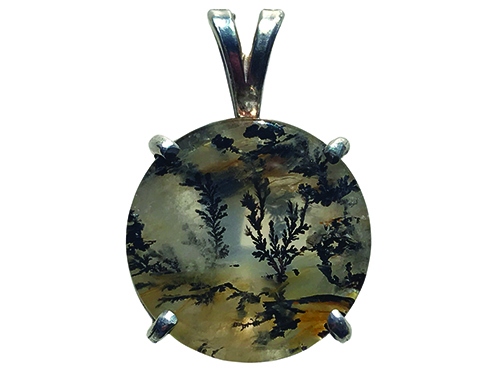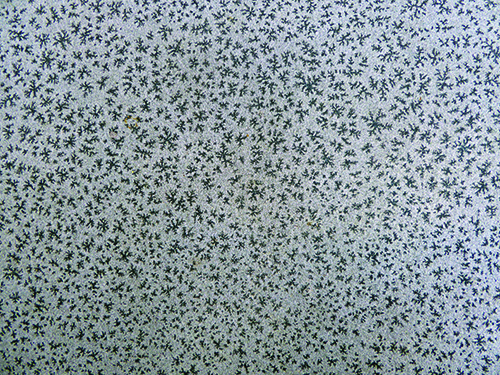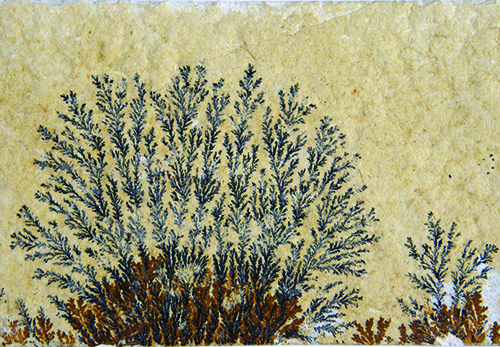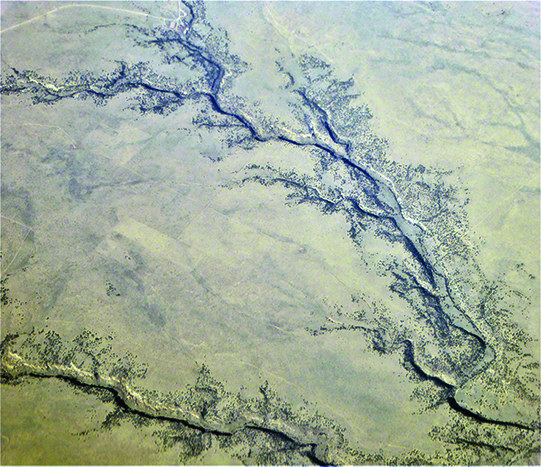
By Jim Brace-Thompson
Editor’s Note: Please enjoy this unique vocabulary lesson via our R&G Kids column.
Mineralogists have a habit of taking a simple concept and giving it a weird word. Such is the case with dendritic. “Dendritic” is simply a fancy way of saying “branching.”
A dendritic pattern is left by a mineral that took on a branching tree- or shrub-like pattern as the mineral formed and solidified. In short, a dendritic mineral is a branching mineral. This outcome is also sometimes called an “arborescent form” from the Latin word abor, meaning “tree.” The word “dendritic” is from the Greek word dendron, which also means “tree.”

A dendritic pattern often is left within bedding planes of sedimentary rock like shale, limestone, or travertine. The mineral creating the dendritic pattern may be a manganese oxide left behind when water rich in manganese and iron flowed between bedding planes. Such dendritic structures are sometimes confused for fossil plants, such as ferns or moss.
The dendritic structures I’ve described are two-dimensional, but three-dimensional dendrites can form within cryptocrystalline quartz. The result is commonly referred to as moss agate. Also, some free-standing three-dimensional minerals (like copper) can take on a dendritic form.
What causes this?

Most crystals grow slowly and uniformly across their surfaces during equilibrium conditions, gradually increasing in size. Dendrites form during non-equilibrium conditions when faster rates of crystal growth generate instabilities, causing crystals to branch rather than grow in one direction. During such periods of quick, unstable growth, the process repeats again and again. The process produces the fractal or branching pattern called dendritic.
By the way, dendritic structures are not formed just by minerals. Certain neuron cells within our bodies are called dendrites or dendrons, and they take on such a branching pattern. On a cold winter day, take a look at frost on a windowpane; you’ll likely see a dendritic pattern. Also, on many plane rides to visit my wife’s family on the East Coast, we’ve flown over rivers and canyons that have carved twisted dendritic patterns in the landscape.
Whether crafted by a mineral, a nerve cell, frost, or a river channel, a dendritic pattern is always beautiful to behold!

All photos by Jim Brace-Thompson.
Author: Jim Brace-Thompson
 Jim began and oversees the AFMS Badge Program for kids and has been inducted into the National Rockhound & Lapidary Hall of Fame within their Education Category.
Jim began and oversees the AFMS Badge Program for kids and has been inducted into the National Rockhound & Lapidary Hall of Fame within their Education Category.
Contact him at jbraceth@roadrunner.com.
If you enjoyed what you’ve read here we invite you to consider signing up for the FREE Rock & Gem weekly newsletter. Learn more>>>
In addition, we invite you to consider subscribing to Rock & Gem magazine. The cost for a one-year U.S. subscription (12 issues) is $29.95. Learn more >>>















